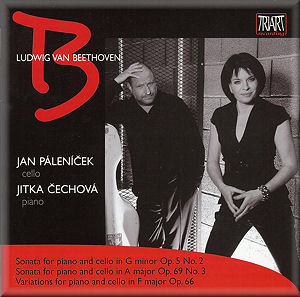 |
 |
|

Buy
through MusicWeb
for £12 postage paid World-wide.
Musicweb
Purchase button
|
Ludwig van BEETHOVEN (1770-1827)
Sonata for piano and cello in G minor, op. 5 no. 2 (1796) [27:16]
Sonata for piano and cello in A major, op. 69 (1808) [26:35]
12 variations for piano and cello on “Ein Madchen oder Weibchen”
from Mozart’s “Zauberflöte”, op. 66 [9:35]
 Jan Páleníček (cello), Jitka čechová (piano)
Jan Páleníček (cello), Jitka čechová (piano)
rec. June, 2010, in Studio Martinek, Prague
 ARCODIVA [no number] [63:51]
ARCODIVA [no number] [63:51] 
|
|
|
Beethoven’s five cello sonatas mark the coming of age of the
cello as a solo sonata instrument. With the exception of cellist-composers
like Boccherini and Romberg, cello parts in the Classical period
reflected subordinate roles. In Haydn’s piano trios, and the
early piano trios of Mozart, the cello was relegated to doubling
the left hand of the piano. From the first of the Beethoven
works for cello, however, the cello found its voice as an equal
partner in a duo sonata. Beethoven was ever the restless innovator,
and his cello writing evolves from the early sets of variations
on tunes from Handel and Mozart operas to the last sonatas.
This disc, by the Czech duo Jan Páleníček and Jitka čechová,
combines two of the most attractive cello sonatas with one of
the sets of variations.
Beethoven wrote the first two sonatas and the first two sets
of variations, in 1796. The G minor sonata, the second of the
five, is a work of alternately melancholic and energetic feeling.
In the first movement an extensive slow introduction with Baroque-like
dotted rhythms is succeeded by a restless fast section. The
finale is a cheerful rondo in G major. The work features plenty
of virtuoso writing for both instruments. From the slow introduction
one notices how backward Jan Páleníček sounds in the balance.
His part is a little more prominent in the fast section, but
he still sounds as if he is struggling to be heard over čechová’s
piano. The balance is particularly hard on Páleníček’s
lower strings; they are hardly audible in the semiquaver accompanying
figure he plays in the finale. The duo adopts a steady tempo
for this movement, paying careful attention to Beethoven’s wide
dynamic contrasts. The final bars are played with a flourish.
The next work on the recording is the A major sonata, the third
sonata in the set. Incidentally it is no. 3, op. 69, not op.
69 no. 3 as the liner notes state; it is the only work given
the op. 69 number. The sonata was written in 1808, which places
it in Beethoven’s middle period, along with works such as the
symphonies 3-8, the Violin concerto, and the “Waldstein” and
“Appassionata” piano sonatas. Like these works, the outer movements
of this sonata are based on short motifs that are elaborated
with great freedom. Its genial and energetic character make
it one of the most attractive Beethoven cello sonatas. Páleníček
enjoys a better balance in this work, although his lower strings
still lack projection. He and čechová adopt a fairly straightforward
approach, without extremes of tempo variation, which works well.
In the second movement the syncopated motifs are not played
too abruptly. Páleníček’s double-stopping is well managed,
as are a very few expressive slides. The finale sees some really
attractive playing, particularly in the question-and-answer
exchanges between the instruments.
The variations feature the best balance of the disc; all of
a sudden Páleníček’s part comes properly into focus. It
is infuriating that this should happen with the least significant
work of the three. The variations themselves are played with
a relaxed charm, and čechová makes the most of the variations
for piano solo.
The Beethoven cello sonatas have been recorded by many illustrious
duos, including the historic Casals/ Horszowski, and Casals/Serkin.
More recently we have had Tortelier/Heidsieck, Du Pré/Barenboim,
and Ma/Ax, to name but a few. There is also an excellent set
on period instruments with Anner Bylsma and Jos von Immerseel
(Vivarte S2K 60761). For comparison with a modern instruments
set I turned to the complete Beethoven music for cello and piano
set by Zuill Bailey and Simone Dinnerstein (Telarc CD-80740).
This latter set is recorded at a much higher volume than the
Arcodiva; the thunderous opening of the G minor sonata made
me jump. As well as being louder, the recording on the Telarc
set is far superior; Bailey never sounds drowned out by Dinnerstein.
This may be due in part to her using a 1903 Hamburg Steinway;
no information is provided about Páleníček and čechová’s
instruments. It may also be that Bailey has the bigger sound
of the two cellists. Given that they have been playing together
since 1997, the confidence of their duo playing could also be
a factor. Bailey and Dinnerstein’s Beethoven sonatas are “big”
readings in every way, with the fortissimo passages given full
weight. Not everything is thumped out, however, the more inward
moments being played with great sensitivity and beauty. They
take about a minute longer over the A major, but elsewhere their
timings are very similar to Páleníček and čechová.
The first time I played Bailey and Dinnerstein’s A major sonata
I found their tempo variations a bit finicky, but I liked it
more this time through. Their set would get my recommendation
over Páleníček and čechová. The Czech duo’s straightforward
approach is appealing, though, and those who like performers
to “just play the notes” would especially enjoy it. Unfortunately
the drawbacks of the recording make it difficult to recommend
this set in the face of such strong competition.
Guy Aron
|
|

